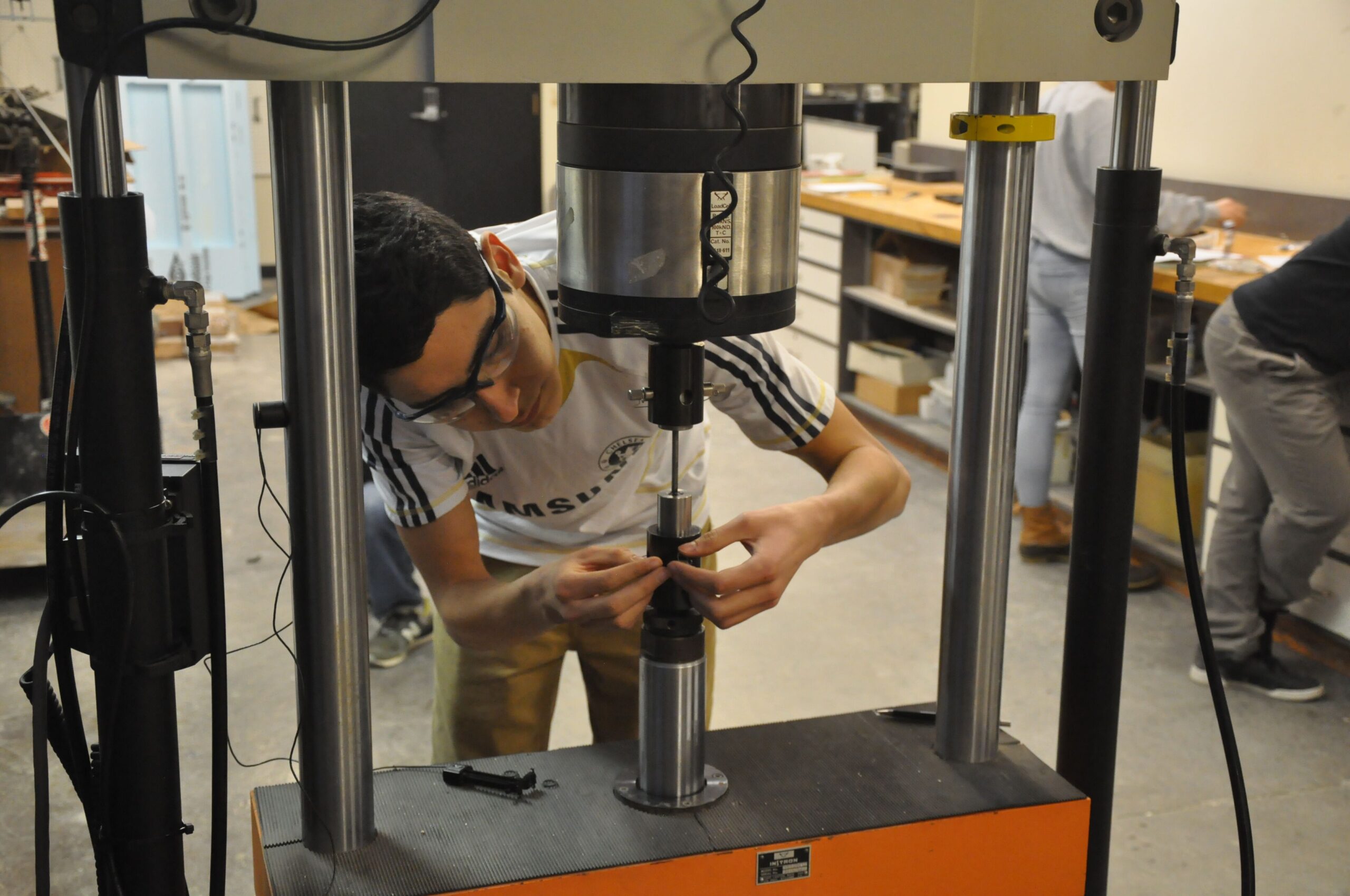
Selecting the right materials for manufacturing processes can be a bit of a challenge. However, among the many factors that need to be considered, strength and durability should definitely be prioritized.
This is why tensile strength is such a critical metric. In this article, we’ll examine the tensile strength definition, as well as other critical things you need to know about the metric.
Understanding Tensile Strength

So, to start with, what is tensile strength?
What does tensile strength mean, in its simplest sense, tensile strength is the highest amount of stress a material can undergo before you start to see changes in its general structure.
Over the years, developments in manufacturing processes have led to the use of different materials – all of which come with their pros and cons. However, being able to ascertain that material is strong enough for the required application is very important. With tensile strength, you’re able to determine a material’s durability and strength.
Also known as tensile stress or compressive strength, this metric is expressed in units that take force against a specific unit area. In a later section, we’ll look more closely at the tensile strength unit.
When a material in tension experiences the impression of force, it gets internal forces that resist the load that has just been applied. A surge in the external force will cause the material to stretch, thus increasing the stress within the material as well. This happens until a maximum point is reached, when the material is deformed and won’t be able to regain its physical properties anymore. This point here is where the tensile strength is maxed out.
Beyond that point, you could see the material experience necking or even a complete fracture. So, understanding the tensile strength meaning is beyond important if you hope to optimize a material’s overall functionality.
As you would expect, the tensile strength of different materials will vary significantly. For instance, the tensile strength of steel will differ from the tensile strength of concrete and the tensile strength of aluminum. And on and on it goes.
To wit, it is also important to conduct a tensile strength test to understand where your specific material lies. A material with a high tensile strength will be useful for different purposes, which we will also look into in a later section.
The Tensile Strength Formula
Ultimate tensile strength formula, now that we’re clear on the definition of tensile strength, let’s look into how to calculate tensile strength itself. Although you could always conduct a tensile strength test, one of the best ways to go about this is to complete the tensile strength formula.
In simple terms, the formula for getting this metric is this:
Tensile Strength = Maximum Load (Force) / Cross-sectional Area
Where:
- Maximum Load (Force) is the highest amount of force that is applied to the material as the test is being carried out.
- Cross-sectional Area is the initial cross-sectional area of the material that was used for the test, perpendicular to the direction of the force being applied. In most cases, this metric is measured in square inches, square centimeters, etc.
Factors Affecting Tensile Strength
In general, various factors can affect a material’s tensile strength. These can be internal – related to the material – or external in the form of being affected by the environment. However, a clear understanding of these factors should help you to know how they come into play:
- Material Composition: First, it is important to consider the chemical composition of the material itself. This is primarily why you see differences in the aluminum tensile strength and the carbon fiber tensile strength, for instance. Different materials and alloys easily combine, and their unique makeups mean that they will also have variations in tensile strength.
- Microstructure: Next, you want to consider the material’s microstructure. This will include things like arrangement, grain size, and more. High tensile strength materials tend to be those with fine-grained microstructures, so consider that in your tensile strength calculations.
- Ambient Temperature: The external temperature also plays a major role in determining this metric. For instance, when calculating the titanium tensile strength, you might find that the metric rises when temperatures are higher – a direct consequence of the softening effect. But, keep in mind that the reverse could easily be the case.
- Material Strain Rate: This factor describes the rate at which the external force itself is being applied to the material. As strain rates differ, materials could easily show different tensile strength readings.
- Manufacturing Process: As you can imagine, the conditions of overall manufacturing can also have an effect. For instance, you might find that the tensile strength of wood reduces after additional refining processes have been performed on it.
- Surface Defects: Scratches, cracks, and other surface defects could significantly affect a material’s overall tensile strength in the long run.
- Loading Direction: Another critical factor to consider will be the direction in which the force itself is applied. This, relative to the grain structure of the material, will come in handy in your overall calculations.
- Strain Hardening: If your manufacturing process for materials like will involve strain hardening, then you might see changes in the tensile strength of plastic as well. Most likely, the metric will increase as the hardening process is implemented.
What Are The Different Types Of Tensile Strength?
So from earlier, we understand the fact that tensile strength is the general name given to a material’s ability to hold pressure without necessarily deforming. However, depending on the context itself, you might be talking about any one of the following types of tensile strength:
Ultimate Tensile Strength
The ultimate tensile strength is most likely what most people refer to when they try to define tensile strength. It represents the highest amount of stress that can be imposed on a material before it breaks or suffers some other form of deformation.
With ultimate tensile strength, you’re looking at the peak point on the stress-strain curve, and the area when the material finally gives way.
Yield Strength
In terms of tensile yield strength, you’re referring to the point when a material starts to undergo deformity without experiencing a corresponding rise in load weight.
For some materials, a point comes when they move from elastic deformation to plastic deformation. At the point when this happens, you essentially have your yield strength reading. So, when you see a tensile strength vs yield strength comparison, you understand which is being referred to.
Proof Strength
You should also be familiar with the proof strength. This metric is quite similar to yield strength, although they differ in the sense that proof strength isn’t universal.
The proof strength refers to the point when a material hits a specific level of plastic deformation. For instance, a material with proof strength as 0.3% offset essentially means that this is the point when it shows 0.3% permanent strain when force is applied to it.
Tensile strength of metal, in most cases, yield strength is used to refer to materials like metals, where “proof stress” as a term can be mixed with “yield strength.”
Tensile Strength at Break
You might also see some experts make reference to tensile strength at break – which is essentially the exact point when a material breaks as the tensile strength test is being done.
Tensile Modulus or Young’s Modulus
In the tensile modulus vs tensile strength comparison, it is worth noting that Young’s modulus isn’t necessarily a classification of tensile strength. However, it does carry a lot of weight when examining overall tensile behavior.
Here, you have a metric that examines a material’s general stiffness and its ability to compress or elongate when forces are applied to it.
With each of these types, you’re able to gain better insights into am materials behavior when it is subjected to forces. And, at KDM Fabrication, we take great care to factor them all when dealing with different materials.
Units Of Tensile Strength
Like every other metric, you need a tensile strength unit to understand just how to represent your figures. And, this is one of those areas where things tend to get a little tricky. There are several tensile strength units, and you need to understand each one specifically.
- Pounds per Square Inch (psi): The psi unit is mostly used in the United States – as well as other countries that rely on the imperial measuring system when representing numbers.
- Kilopascals (kPa): You might think that kPa is mostly affiliated with pressure. However, in countries that use the metric system, it is actually applied in representing tensile strength.
- Megapascals (MPa): Also used in metric systems, MPa is especially applied in material science and engineering recording.
- Newton per Square Millimeter (N/mm²): Another unit tensile strength, this one is among the less popular variants.
- Atmospheres (atm): Also less common, this unit of tensile strength works in some specific contexts.
- Bars (bar): Among the units of tensile strength, the bar also works in specific scenarios.
Remember – when dealing with data for this metric, using the right unit and measurement goes a long way in making your work cleaner.
How To Determine A Material’s Tensile Strength

When the time comes to determine a material’s tensile strength, you want to get it tested out. Standardized tensile strength tests – or, the tension test, if you will – allow you to properly understand a material’s response to applied forces and external stimuli.
Generally, the process goes thus:
Sample Preparation
As expected, you want to begin by testing the sample itself. Prepare it in the right size and shape, based on the laid out testing protocols and other relevant standards.
Depending on the situation, the sample could be a wire, bar, strip, sheet, etc. As long as you have the right material type and application, you shouldn’t have a problem.
Mounting the Sample
Tensile strength machine, once the sample is prepared, mount it carefully into the tensile testing machine. The machine comes with clamps and grips that operate on both ends of the sample, holding it firmly as the carbon steel tensile strength test is going on.
It is also important to calibrate the machine to zero in order to get the right readings. Your calibration will set the reference point for the force, as well as allow you to take proper material deformation readings.
Applying Tensile Force
Once it is on, the testing machine is made to apply a steady level of tensile force to the material. This force will eventually increase, with the increase being monitored and constant over time. Just as well, keep in mind that the force should be applied axially, essentially stretching the sample across its length.
Recording Load and Elongation
As part of the overall test, the machine will have to take two important readings – the applied force and the sample’s level of elongation. It is important for these two metrics to be maintained, so you can track them and make your stress-strain curve.
Calculating Tensile Strength
With the stress-strain curve ready, you can take readings and determine the overall tensile strength. Get the peak point on the curve, and you can find your tensile strength.
Also, remember that you can always buttress these calculations with the mathematical formula
Yield Strength
This isn’t necessarily compulsory, but you might notice that the material will also exhibit a clear yield point on the curve. If this is the case, then you will most likely be able to determine the yield strength as well.
Analysis and Reporting
Finally, analyze the data you got to understand the material’s overall mechanical behavior. Remember that materials exhibit different readings, so the tensile strength of glass won’t be the same as the tensile strength of bamboo, for instance.
Document everything you have, and you’re good to go.
Typical Tensile Strength Ratings
Tensile strength can be a bit of a pain to handle. However, by understanding some of the standard material ratings, you should be able to make quicker decisions on material selections:
| Material | Tensile Strength (MPa) | Tensile Strength (psi) |
| Mild Steel | 400-500 | 58,000-80,000 |
| Stainless Steel | 500-2,000 | 72,500-290,000 |
| Aluminum (6061) | 240-290 | 35,000-42,000 |
| Copper | 210-350 | 30,500-50,800 |
| Titanium | 900-1,400 | 130,500 – 203,000 |
| Nickel | 400-900 | 58,000 – 130,500 |
| Brass | 280-550 | 40,600 – 79,750 |
| Bronze | 350-550 | 50,800-79,750 |
| Cast Iron | 100-400 | 14,500 – 58,000 |
| Zinc | 100-150 | 14,500 – 21,750 |
| Magnesium | 140-260 | 20,300 – 37,700 |
Is Tensile Strength The Best Measure Of Material Durability?

When measuring the strength of a material, it is important to note that there are several measures to be kept in mind. Tensile strength examples easily provide the metrics needed, but you should know that there are other measures.
So, how does tensile strength compare with the others?
Tensile Strength vs. Compressive Strength
While they are similar, tensile strength and compressive strength aren’t quite the same thing. Below is a look into some of their differences:
- Definitions: Tensile strength itself explains the highest amount of tensile stress that a material can hold without losing its form. On the other hand, compressive strength refers to how much compressive stress a material is able to withstand before failing.
- Stress Direction: You also need to consider the stress direction when doing the tensile vs compressive stress comparison. To get tensile strength, you subject the material to stress coming in the direction of stretching. On the other hand, compressive stress has to go in the direction of squeezing or compression to count.
- Deformation Type: When measuring tensile strength, the material needs to resist stretching or elongation. For compressive strength, however, the material needs to resist shortening and compression.
- Test Methodology: Generally, you measure tensile strength using a tensile strength test – the material is pulled, and you take readings from there. For compressive strength, the sample undergoes a considerable compressive force, with readings being taken from there.
- Overall Magnitude: In specific materials, you might notice that both compressive and tensile strength tend to have different magnitudes. For instance, you might find materials with higher tensile strength than compressive strength, while others might go the other way around.
Tensile Strength vs. Shear Strength
Next, let’s consider shear strength vs tensile strength.
Generally, a material’s shear strength determines how much shear stress it is able to hold in without deforming when it is subjected to parallel forces. To understand the differences between these two, consider the following:
- Stress Direction: While tensile strength involves stress in the elongating direction, shear strength involves stress coming in a direction that is parallel to the materials plane.
- Deformation Nature: Tensile stress deals with elongation, while shear stress considers sliding motions.
- Test Methodologies: To test tensile strength, you have to stretch the sample to its limits. For shear strength, you apply forces to the material via its surface directly.
- Magnitude: In most cases of the tensile strength vs shear strength comparison, you would find that the latter tends to be lower. This is mostly because materials tend to be stronger in resisting pulling forces than those operating paralel to their surfaces.
Tensile strength vs Flexural Strength
Finally, let’s look into flexural strength vs tensile strength. Both as similar, as you’d imagine – but, they tend to differ as well.
In flexural strength, you’re looking at the amount of stress a material can withstand when it is subjected to a force that looks to bend its structure. So, how does the difference between flexural strength and tensile strength work out?
- Loading Type: While tensile strength tests a material’s response to pulls, flexural strength looks to see how it acts when you apply forces to its length.
- Test Method: To measure tensile strength, you take the material and see how long you can pull it. For flexural strength, you load the sample on its surface and see the amount of bending it can take.
- Magnitude: Flexural strength and tensile strength can be compared, although in most cases, the latter tends to be higher. As you can imagine, the inherent strength of many materials tends to be higher for pulling forces than bends.
Getting The Most Tensile Strength From Any Material
Everyone wants material that is strong and durable, no matter what. And, it can be a bit frustrating when you find that your material doesn’t have the appropriate tensile strength rating.
Nevertheless, there are methods that can be taken to improve the readings you get when you conduct your test. Some of these include:
Alloying & Material Composition
The introduction of additional elements or alloys to the material itself can help to optimize its tensile strength. Bonds within the material get stronger, and you can also improve the material’s microstructure. All in all, tensile strength is improved.
Heat Treatment & Quenching
A similar trend can be achieved with heat treatment. Take the material, heat and cool it at controlled paces, and you will be able to make changes to its microstructure and internal lattice. Whether it’s tempering or quenching, these processes do work wonders.
Cold Working & Annealing
With cold working, you take a material and make changes to it at controlled temperatures. This process eventually gives way to strain hardening, thus improving both yield and tensile strength where applicable.
Even better, cold working als2o maintains the material’s ductility. So, you get dual benefits here.
Grain Refinement
If you add grain refining agents to cut down on the materials grain size, then you should be able to see a direct increase in tensile strength. With smaller grains, dislocation movement can be dropped, thus optimizing durability.
Precipitation Hardening
For this process, you raise the material’s temperature and age it. This leaves way for precipitates to form, which will in turn reduce dislocation motion and improve the overall strength of the material across the board.
Surface Treatments
You could apply shot peening and other surface treatments – as well as incorporate operations like nitriding – to create a stronger layer on the materials surface, thus optimizing its durability.
Nanostructuring
While it might not be a popular operation, nanostructuring can also have impressive benefits for optimizing a material’s tensile strength. With nanotechnology, you can design materials with unique molecular structures, thus making changes to its strength profile as well.
Now, it is critical to note that these methods can have different efficiency levels. They will still depend on the factors we mentioned above – temperature, material composition, etc. Nevertheless, we at KDM Fabrication understand just how best to help you improve your tensile strength unit if you need it.
Possible Challenges and Limitations of The Traditional Tensile Strength

Like every other mechanical property, there are bound to be a few issues with the ultimate strength rating. Some of these challenges could include:
- Anisotropy: As we already pointed out, tensile strength is never as simple as you can imagine. The biggest factor here is the direction of the force being applied, especially relative to the overall grain structure of the material. Considering that materials exhibit their own brand of anisotropic behavior, it can definitely complicate selection and design across the board.
- Temperature Sensitivity: Changes in ambient temperature can also completely take your calculations and readings out of whack. This is why you need to perfectly understand your chosen material’s behavior at different temperatures – especially for sensitive applications.
- Strain Rate Sensitivity: We already defined strain rate earlier. Interestingly, this factor can go a long way in influencing its response to the forces acting on it. Some materials can display different strength levels at different strain rates, and this can come in handy in dynamic loading instances.
- Brittle Failure: Some materials come with high tensile strength but can still encounter failure suddenly. Due to their general lack of ductility, they have low rates of plastic deformation, meaning that they won’t work when you need optimal energy absorption.
- Defect Sensitivity: If you find a material with an inherent defect such as an inclusion or a void, you might see it having low tensile strength. This is due to the fact that these defects tend to soak up a lot of stress and can act as possible initiation sites for further breakage.
- Scale Dependency: While testing, you essentially take a sample of the product and see how well it does with stretching. However, the problem here is that the size of the sample itself could also influence the readings you get. Scale differences can influence your overall readings, and this might lead to inaccuracy across the board.
- Environmental Effects: As a material gets more exposure to harsh environments, its durability will most likely drop as well. This is why you want to keep an eye on environmental factors if you’re choosing materials for your applications.
- Sample Variability: Many traditional properties tend to vary slightly, even while in a material batch. And, tensile strength is no different from this. This is why it is important to ensure standardization in testing steps and when preparing your testing sample.
- Time Dependency: Finally, some materials could also exhibit behavior that varies based on the time. With the presence of creep, there is always the risk of deformation and gradual, eventual failure.
Tensile Strength At Break: The Most Underrated Tensile Strength Variant
Of course, it would be almost impossible to talk about tensile strength without mentioning the metric of tensile strength break.
Here, you’re looking at the maximum amount of tensile stress that a material will be able to go through during a test. Tensile strength at break is critical as a mechanical property because it shows a material’s optimal ability to bear load, especially when under stress. It provides an understanding of the material’s ability to withstand tensile forces, and it is a huge consideration in material selection regardless of the industry.
Conclusion
Regardless of the industry, choosing a material that’s strong enough for your intended application. This is why the tensile strength metric tends to come in especially handy.
If you’re looking to learn more about tensile strength or optimize the durability of your material through different means, KDM Fabrication is the company for you. Reach out to us today, and let us know how we can help you.




